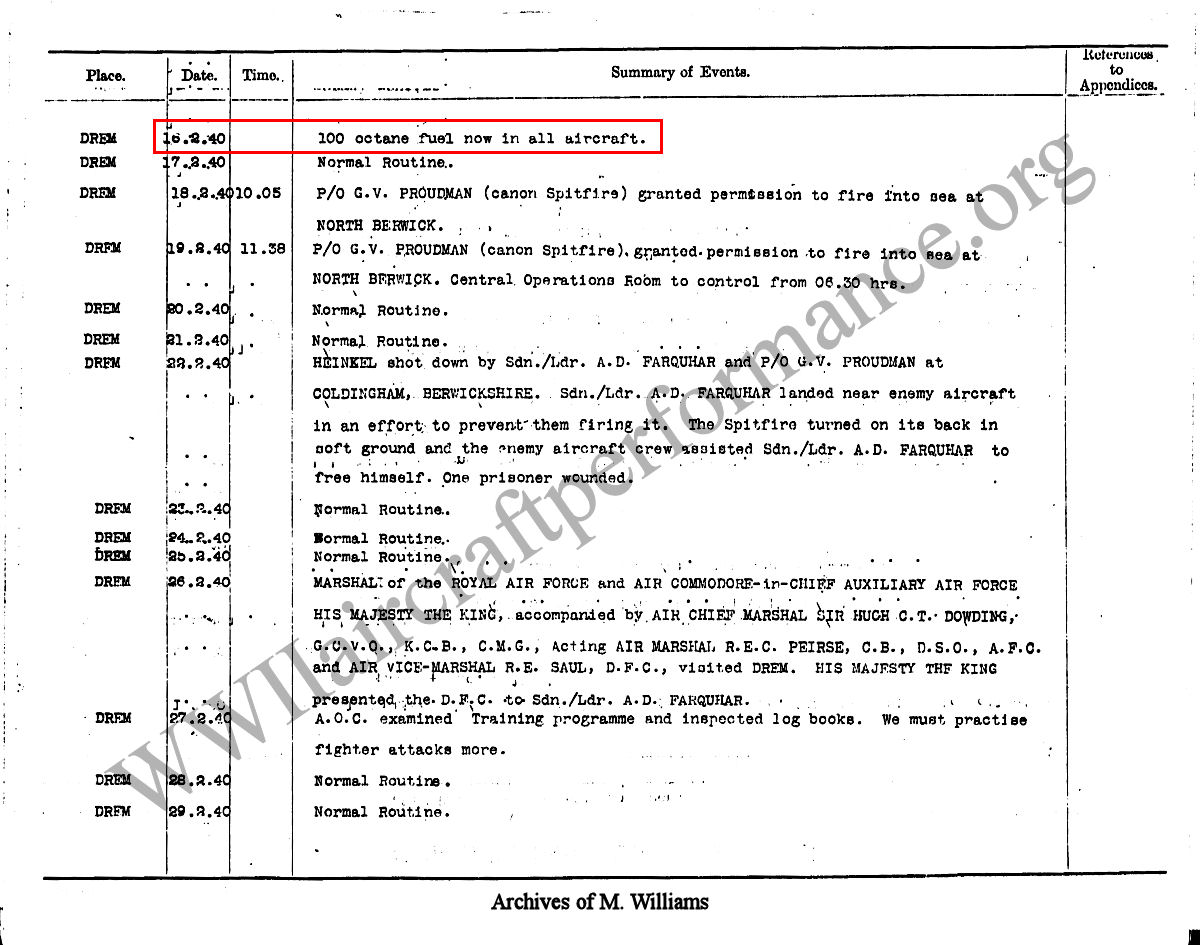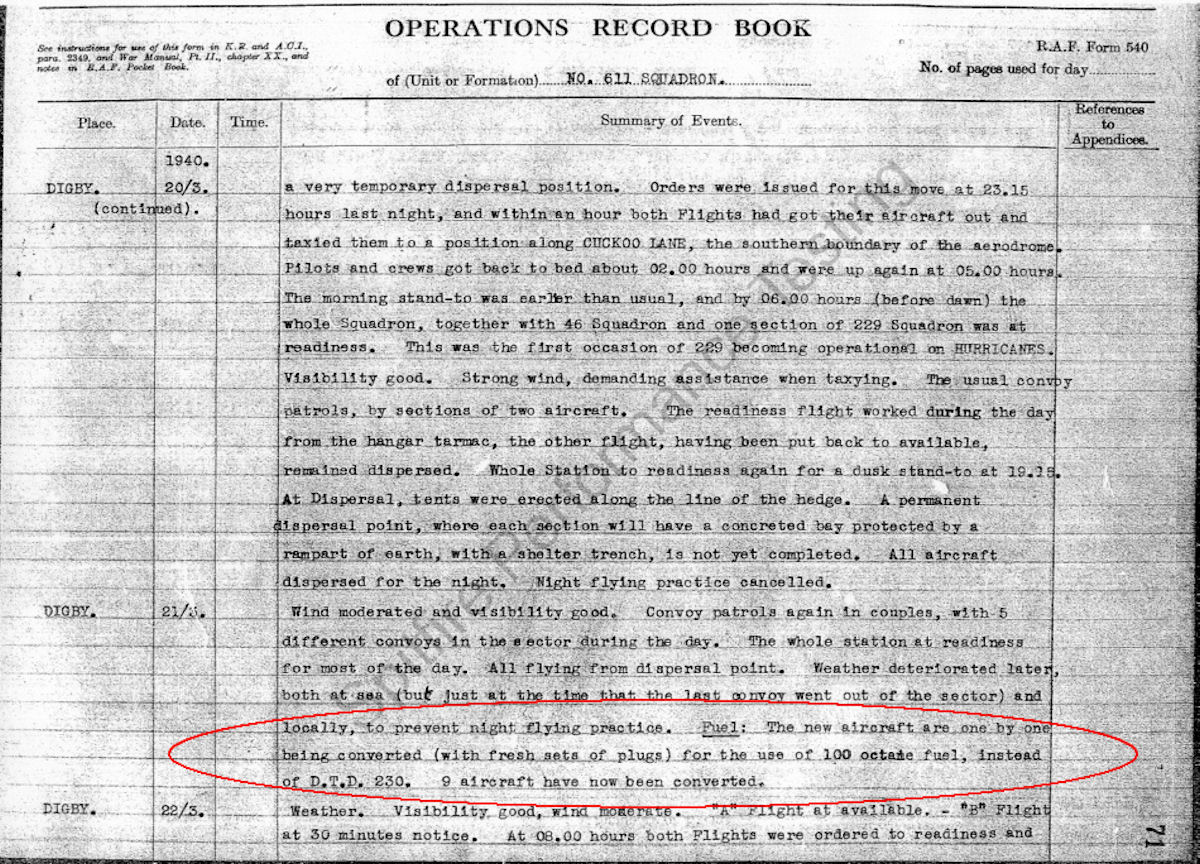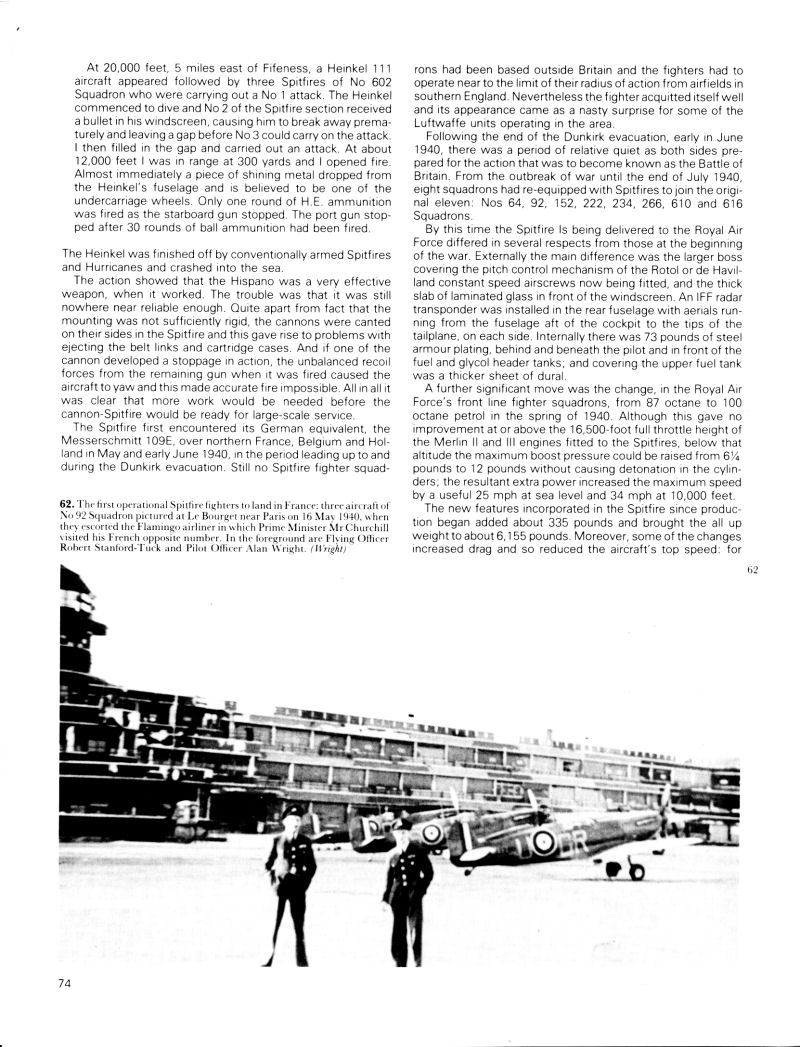
 |
|
#451
|
|||
|
|||
|
There is plenty of documentation of 100 octane fuel use before and during the Battle of Britain. For starters:
  602 Sqdn. Operations Record Book  611 Sqdn. Operations Record Book  151 Sqdn. Operations Record Book  74 Sqdn. Operations Record Book  111 Sqdn. Operations Record Book  David Ross, The Greatest Squadron of Them All, The Definitive History of 603 Squadron, RAauxAF, (Grub Street, London, 2003)  Alec Harvey-Bailey, The Merlin in Perspective, (Rolls-Royce Heritage Trust, Derby, 1983)  Alfred Price, The Spitfire Story, (Arms and Armour Press Ltd., London, 1986)  Leo McKinstry, Hurricane, Victor of the Battle of Britain, (John Murrey Publishers, London, 2010)  Leo McKinstry, Hurricane, Victor of the Battle of Britain, (John Murrey Publishers, London, 2010)  W.G. Dudek and D. R. Winans, excerpt from AIAA Paper No. 69-779, Milestones in Aviation Fuels, (Esso Research and Engineering Company, New York 1969.)  A. R. Ogston, excerpt from History of Aircraft Lubricants (Society of Automotive Enginees, Inc. Warrendale, PA USA), p. 12.  RAF History  602 Sqdn. Spitfire I  609 Sqdn. Spitfire I  610 Sqdn. - Hawkinge, July 1940 
Last edited by lane; 02-29-2012 at 02:00 PM. |
|
#452
|
|||
|
|||
|
I know that and I thank you for your posting, but it cannot be questioned that central to the Pips position is that there was a shortage. All I am asking is for Kurfurst to provide any evidence, that any part of the UK government, any department, considered there to be a shortage of 100 octane for FC, at any time during the BOB.
There are a raft of papers to the contrary and I could add a load more to your posting but I am not asking Kurfurst for that, I am just asking him to provide one paper, just one, that says there was a shortage. It shouldn't be that difficult, hundreds of papers, books, articles, personal memories, histories have been written about the battle. There must be one that agrees with him. |
|
#453
|
|||
|
|||
|
Quote:
In response to your claim in point 3 of your post (434) on page 44, and I quote you said "the petrol normally used at that time was 87 Octane" I find this slightly misleading as the time in question is 1937, which you did not state nor was there an attempt to put the quote in context. Whilst it does say on Page 557 of the original text (link) that “the petrol normally used at that time was 87 Octane” it is referring a to pre-war flight endurance test in 1937 where the Spitfire in question used “fuel of a higher Octane” (than 87 Octane). Note, this is stating that in 1937 the petrol normally used was 87 Octane – it does not mention the normal Octane used during the Battle of Britain 3 years later in 1940. I fail to see the significance of this quote regarding Octane usage during the Battle of Britain when we examine the whole quote. If I have missed any quotes in the document regarding 87 or 100 Octane fuel usage during the Battle of Britain, and I may well have done considering it's a huge document, could you please quote them directly and list the page in the document that they appear so we may examine them in full. For example as I have done above by stating the quote and it’s appearance on page 557 with a working link to the page. Thanks. Quote:
MoGas, could you post a summary or even better images of the article you are referring to in english since it seems the magazine you are referring to requires a subscription. Thanks, Bounder Last edited by Bounder!; 02-29-2012 at 03:25 PM. Reason: found the document in question |
|
#454
|
|||
|
|||
|
This is what Pips said about what he found when asked: "were the British deceiving to the Australians?"
Quote:
(It seems that the one accusing others of being selective is himself being selective.) tut tut There is certainly evidence that this was a deception for British stocks of 100 octane fuel was: 30th September 1939 - 153,000 tons 27th February 1940 - 220,000 tons 31st May 1940 - 294,000 tons 11th July 1940 - 343,000 tons 31st August 1940 - 404,000 tons 10th October 1940 - 424,000 tons 30th November 1940 - 440,000 tons |
|
#455
|
|||
|
|||
|
Quote:
"In the article it is written, that, since early 1940, WHEN possible, EVERY fighter Sqn, got 100 octan fuel!" ,"Since the end of 1939, the focused already on 100 octan fuel, to rise the performance on the engines" ,"The RAF used 100 octan since 1937 already, but it was limited very much, because, he was coming from the USA, and it was expensive" I will scan the text, or page, but I dont like to fall in a copyright issue, if you know what I mean.. Last edited by MoGas; 02-29-2012 at 04:00 PM. |
|
#456
|
|||
|
|||
|
This graph is garbage as it includes 87 fuel issued to all RAF Commands. It is also unreferenced as to the source of the data plotted. |
|
#457
|
|||
|
|||
|
Hi Bounder!,
The number of pages concerning the article (exception made of the 2 pages of adds) is only 3 pages p576 to 579. It seems for me that quoting the page was of no importance as I alrdy took great care of extracting for the reader AND in the same order what was the essential for the discussion. That article was written at the occasion of the commemoration of 40 year of aero engine dev by RR and 50 years of History. The article is filled with 1 page add of RR. Obviously, we can understand that as it is today the article might hve been reviewed by RR ! The journalist of FLIGHT (H. F. K I N G , M . B . E) use a chronological order in his article and describe any major evolution of that engine IN THAT ORDER. For example if he specified that 87 octane was the fuel grade in use at the time, when 100 oct fuel is introduced in an engine he noted the modification. For example he clearly explains that if Hurri and Spits did rely on the Mk II and III, the Fulmar equipped with MkVIII could be fueled with 100 octane (with a max output power of 1080shp at T.O contrary to 1010 without - without meaning obviously with 87 ocatane On point 1: yes we are talking abt 1937. It's the beginning of the article that deal chronologically with the Merlin story. To say that the 87 oct fuel was the normal fuel used at that date I am using the quote on point 7 saying that using 100 oct fuel the Merlin XX had a 9lb boost The date I mentioned (remark that I didn't re-use the 1942 date as in the FLIGHT article) is in perspective with the service introduction of that engine as in my own memory. Note also that there is no mention of any use of the XX engine in the Spitfire but one on how the process of introducing that level of improvement was difficult ("These figures represent an increase of nearly 250 h.p. over the Merlin II of identical cylinder dimensions, and illustrate in a convincing manner the technical progress achieved by years of 'toil, tears and sweat,' to borrow a classical phrase from our worthy Prime Minister.") All that makes sense to me on the base of technical grounds. The quote made out of the rest of article are there to put the subsequent development in perpective regarding SHP and boost with the ultimate being 25lb for the post war 131/132 on the Hornet. Hence we have two door in the Merlin history acording to the article : one in 1937 for introduction of 87 octane (confirmed in 1940 with the mention made of the Fulmar using a special engine) and the other in 1941 (42 in Fligt article) for possibility of 100 octane usage in the mkXX. After that date it's upon the reader to decide witch fuel was in use since the article does not mention any switch (witch I found interesting despite all the other details of the engine modifications) but it's another story Note also that in 1954, the merlin with 150000 units produced (all manufacturer included) represented more than 80% of all engines build by RR at the time (185000) Source : http://www.flightglobal.com/pdfarchi...0-%201286.html Last edited by TomcatViP; 02-29-2012 at 04:53 PM. |
|
#458
|
|||
|
|||
|
Quote:
The article covers the start of Rolls Royce and goes on to discuss the development of the Merlin engine. What I gather from your posts is that you are basing your argument that, when the Merlin II and III engines where first tested they used 87 Octane fuel, I have no problem with that. You are then saying that when the Merlin XX engine was introduced later in 1941 it ran on 100 Octane fuel, again I have no problem with that. The problem I have with your argument is that it assumes Merin II or III engines could not or were not be modified to run on 100 Octane fuel – this is not stated in the article and is contrary to all the evidence posted in this thread and historical accounts showing that Spitfires and Hurricanes were converted to 100 Octane fuel before the Battle of Britain. ----------------------------------------------------------------------------------------------------------------- PS: Thanks MoGas, I wouldn't post any scans if it could cause copyright issues. ----------------------------------------------------------------------------------------------------------------- Just for the record, my concern regarding the whole 87 vs 100 Octane fuel stemmed from previous information that seemed to indicate at the time that CoD would not offer official models of the same aircraft with different octane fuel (link to post http://forum.1cpublishing.eu/showthr...439#post389439). My worry is that if only one octane model per aircraft will officially be supported that we will get official models using 87 Octane fuel without corresponding models using 100 Octane. Given the overwhelming evidence of 100 Octane fuel used by Spitfires and Hurricanes during BoB against the complete lack of evidence for those aircraft flying combat sorties using 87 Octane fuel, having official models only using 87 octane would, in my opinion, be historically inaccurate. I understand that once the SDK pack is released players could model their own variants and I feel that if people want to model 87 octane Spitfires and Hurricanes that would be great and allow for more choice, particularly in dynamic campaigns where the LW successfully target enough RAF fuel supplies, bases etc forcing RAF fighters into 87 Octane fighters. Also, I don’t have a problem with variants of the Spitfires and Hurricane we have in game modelled officially with both 87 and 100 Octane, then it’s up to the user / mission designer to pick. But if we can only have one variant per model, then it should in my opinion be the 100 Octane variant since all the evidence supports 100 Octane fuel use in BoB. Last edited by Bounder!; 03-01-2012 at 12:53 AM. |
|
#459
|
|||
|
|||
|
Quote:
Thanks in advance |
|
#460
|
|||
|
|||
|
Yes Banks that was in the thread Barbi so loves to quote from. Pips, afaik, has not been from in years.
Sign up on the board. Lots of interesting info has been posted, though the board is rather dead now. |
 |
| Thread Tools | |
| Display Modes | |
|
|